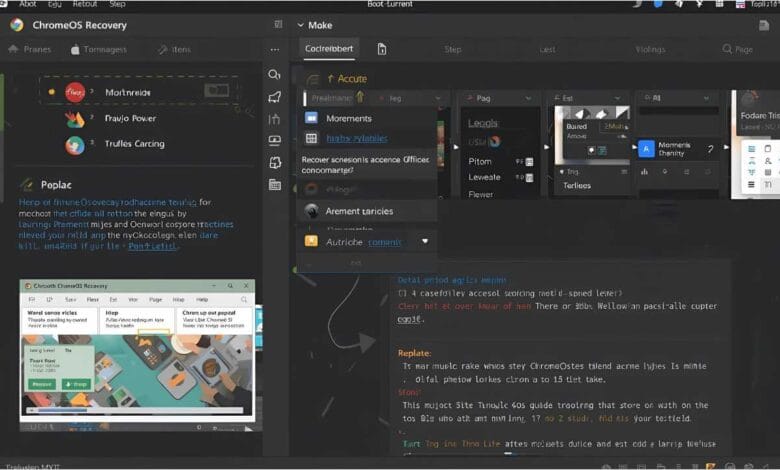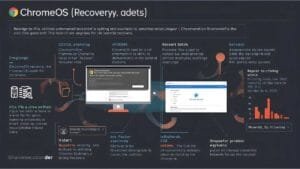
ChromeOS Recovery Guide for Smooth System Restore
Is your Chromebook acting up? Maybe it’s stuck in a boot loop, won’t turn on properly, or keeps crashing. When all else fails, ChromeOS recovery can come to the rescue. This built-in tool lets you reinstall the operating system, wipe corrupt files, and bring your device back to life.
But before jumping in, you need to understand how this works, what tools you’ll need, and when it’s truly necessary. Don’t worry—this guide will walk you through everything in a simple, stress-free way.
What is ChromeOS Recovery and When Should You Use It?

ChromeOS recovery is a process that completely reinstalls the operating system on your Chromebook. It’s not the same as a simple reset or powerwash. While a factory reset keeps your ChromeOS intact and just clears local data, a recovery wipes everything, including the system files, and downloads a fresh copy of ChromeOS.
This process is useful in cases like:
- A corrupted ChromeOS install
- A Chromebook that won’t boot
- Repeated system crashes or errors
- A failed update that broke the system
- You’re preparing the device for a full reset and reinstall
Here’s a quick comparison between the Powerwash and ChromeOS Recovery:
| Feature | Powerwash | ChromeOS Recovery |
| Clears user data | ✅ | ✅ |
| Reinstalls OS | ❌ | ✅ |
| Fixes boot issues | ❌ | ✅ |
| Requires recovery media | ❌ | ✅ (USB or SD card needed) |
| Time to complete | Fast (2–5 mins) | Longer (15–30 mins) |
| Ideal for | Light cleanup | Major system errors |
So if your Chromebook is misbehaving badly and simple fixes don’t work, recovery is your best bet.
What You’ll Need to Start the Recovery Process
Before you begin, make sure you have the following:
- A working computer with Chrome browser installed
- A USB flash drive or SD card (at least 8 GB)
- Your Chromebook model number (shown on the recovery screen)
- A stable internet connection
Google provides a free tool called the Chromebook Recovery Utility, which you’ll install on your working computer to create the recovery drive.
Steps to Perform a ChromeOS Recovery

Now let’s walk through the recovery process, step by step. This part is straightforward, but be patient and follow the instructions closely.
Install the Chromebook Recovery Utility
Open Chrome on a working computer and go to the Chrome Web Store. Search for Chromebook Recovery Utility, then click “Add to Chrome.”
Once added, launch the extension.
Get Your Chromebook’s Model Number
If your Chromebook shows a recovery screen with a sad face or error code, you’ll usually see the model number there. Write it down. If not, Google’s recovery tool can help identify it.
Insert the USB or SD Card
Plug in your USB drive or SD card (at least 8GB) to the working computer. Backup any files, as this will erase the drive.
Create Recovery Media
Launch the Recovery Utility, type your model number or choose your device from the list, and follow the on-screen prompts. The tool will download the correct ChromeOS version and create a recovery image.
This step may take 10–15 minutes depending on your internet speed.
Enter Recovery Mode on Your Chromebook
Insert the recovery USB or SD into the broken Chromebook. Then use a key combo to enter recovery mode:
- Most models: Esc + Refresh + Power
- For tablets: Press Volume Up + Volume Down + Power together
Once you’re in recovery mode, the screen will prompt you to insert recovery media.
Reinstall ChromeOS
After you insert the recovery media, the Chromebook will begin reinstalling the OS. Let it finish—don’t unplug or power off. Once complete, it will restart automatically.
Remove the recovery drive when prompted.
What to Do After ChromeOS Recovery
When the system restarts, you’ll go through the initial setup just like a new device—language selection, Wi-Fi setup, signing into your Google account.
At this point, your Chromebook should be fully functional again. If problems continue, the issue might be hardware-related.
Common Errors and How to Fix Them During Recovery
ChromeOS recovery usually runs smoothly, but here are a few common issues people encounter:
| Error Code | What It Means | How to Fix |
| 0x5 | Corrupt recovery image | Re-download the recovery tool |
| 0x6 | Drive write error | Try another USB or SD card |
| 0x7 | Internet connection problem | Check your Wi-Fi, retry download |
| 0x8 | Model number mismatch | Re-check your Chromebook model |
If you’re stuck or unsure, visit Google’s Chromebook Recovery Help.
Best Practices to Avoid Needing Recovery

While ChromeOS is lightweight and stable, here are a few tips to avoid needing a recovery:
- Keep your device updated regularly
- Avoid installing unverified apps or extensions
- Don’t interrupt system updates once they start
- Back up your Google Drive regularly (ChromeOS saves most things in the cloud, but some local files may still exist)
Final Thoughts
ChromeOS recovery is a powerful tool that can bring a “dead” Chromebook back to life. Whether you’re dealing with stubborn crashes, failed updates, or an unbootable device, this method resets everything cleanly and safely. It’s not something you’ll need every day, but when the moment comes, it’s a life-saver.
By following the steps carefully and preparing in advance, you can confidently handle even the scariest system issues your Chromebook throws at you.
Q&A: Frequently Asked Questions
Q: What happens to my data during ChromeOS recovery?
A: All local data will be erased. Files stored on Google Drive or cloud-based apps won’t be affected.
Q: Is ChromeOS recovery the same as Powerwash?
A: No. Powerwash is a factory reset that clears user data but doesn’t reinstall the OS. Recovery wipes everything and reinstalls ChromeOS.
Q: Can I use a smartphone to create recovery media?
A: No. You need a computer with Chrome installed to use the Chromebook Recovery Utility.
Q: What kind of USB drive should I use for recovery?
A: Any USB flash drive (8 GB or more) will work. Avoid using USBs with multiple partitions or encryption.
Q: How long does ChromeOS recovery take?
A: The whole process—from creating the drive to reinstalling ChromeOS—typically takes 20 to 30 minutes.
Q: My Chromebook still won’t boot after recovery. What should I do?
A: Try the process again with a different USB drive. If it fails again, it may be a hardware issue and you should contact support.
Q: Can I cancel the recovery process once it starts?
A: It’s not recommended. Interrupting recovery can leave your Chromebook in an unusable state.





